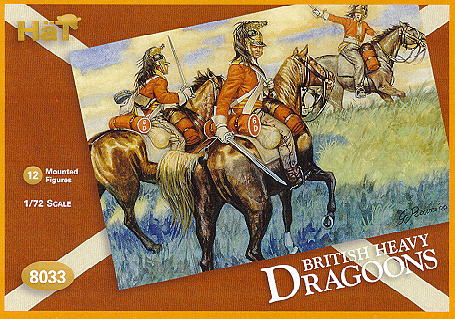
British Dragoons Box



 During the Napoleonic wars, the British heavy cavalry consisted of the Guards cavalry regiments (1st and 2nd Life Guard, Horse Guards), 5 regiments of Dragoons and 7 reigments of Dragoon guards, the former regiments of horse, who received their title to distinguish them from the Dragoons, without actually being part of the Guard.
During the Napoleonic wars, the British heavy cavalry consisted of the Guards cavalry regiments (1st and 2nd Life Guard, Horse Guards), 5 regiments of Dragoons and 7 reigments of Dragoon guards, the former regiments of horse, who received their title to distinguish them from the Dragoons, without actually being part of the Guard.
The main actions fought by the heavies were the campaign in the Peninsular and the Waterloo campaign. Wellington mistrusted his cavalry, mainly because of the lack of competence of their leaders. Once they charged home, they usually attacked with all available forces, without leaving reserves and were next to impossible to rally, which usually put them in disadvantage to the french, who countered their attacks with proper reserves, inverting initial british successes into painful defeats. One of the most famous charges was the one of the Union Brigade 1st, 2nd and 6th dragoons) at Waterloo, where this happened exactly, and the whole brigade was practically annihilated as a fighting force.
In 1812 considerable changes in dress took place. The bicornes worn until then were replaced by two new types of helmets, the first pattern with a woolen crest issued to all line regiments and the second pattern, very much like the french heavy cavalry helmet, given to the Guards. At the end of 1813, this scheme was reversed.Thus from 1813 onwards all Dragoons and Dragoon guards had the black leather helmets with brass fittings andf a horsehair mane.
The coats all looked quite the same, distinguished only by the different facing colours and laces, which were gold and silver respectivly for officers. The facing colour was visible on collar, cuffs and turnbacks, the lace in 2 double rows down the front and around cuffs and turnnbacks with a broad girdle of the same colour. Dragoon guards had blue facings for the 1st (yellow lace) and 4th (white lace), black for 2nd (w.l.)and 7th (y.l), white for the 3rd (y.l) and 6th (w.l.) and green for the 5th (y.l.) The Dragoons facings were blue for 1st and 3rd (both yellow lace), green with white lace for the 4th and yellow with white lace for the 6th. The 2nd Dragoons were the famous Scots greys (blue facings, white lace) who wore a bearskin cap instead of the helmet.
On campaign grey overalls with brown leather reinforcements and red side stripes were worn. Sabretaches were plain black. No standards were carried in the field. Most of the units had docktailed their horses, which were usually bays or browns of a dark shade. Only the 3 Guard regiments had black horses. Trumpeters usually rode whites or greys, as did the whole 2nd regiment.
The figures can be painted ad Dragoons and Dragoon Guards post 1813 as well as Life Guards from 1812-14.
Alfred Umhey
Germany
(Edited for length on box.)
Copyright 2000. All rights reserved. Any unauthorized use of content or images are violations of applicable laws and will be prosecuted to the fullest extent of the law.